Table of Contents
About
A South Indian platter is a delicious and diverse assortment of vegetarian dishes that are native to the southern region of India. The South Indian platter is a combination of aromatic rice, lentils, vegetables, and an array of chutneys and sambar.
Some of the most popular South Indian dishes included in the platter are idli, dosa, vada, sambar, coconut chutney, tomato chutney, rasam, rice, and yogurt. The platter is usually served on a banana leaf or a thali and is a perfect representation of the vibrant and flavorful cuisine of South India.
South Indian Platter is known for its unique flavors, textures, and the use of aromatic spices and herbs. South Indian Platter cuisine is heavily influenced by the coastal region and has a focus on vegetarian food. The use of coconut, tamarind, and curry leaves is common in the cuisine, making it distinct from other regional cuisines in India. Overall, a South Indian platter is a wholesome and satisfying meal that is perfect for anyone looking to experience the rich and diverse flavors of India.
For Sambar
To make dosa sambar at home, you will need to follow these steps:
Ingredients:
- 1 cup toor dal (split pigeon peas)
- 2 cups water
- 1 teaspoon turmeric powder
- 1 teaspoon salt
- 1 teaspoon oil
- 1 teaspoon mustard seeds
- 1 teaspoon cumin seeds
- 1 onion, chopped
- 2 tomatoes, chopped
- 2 green chillies, slit
- 1 tablespoon tamarind pulp
- 1 tablespoon sambar powder
- 1/4 teaspoon asafoetida powder
- Curry leaves
- Coriander leaves
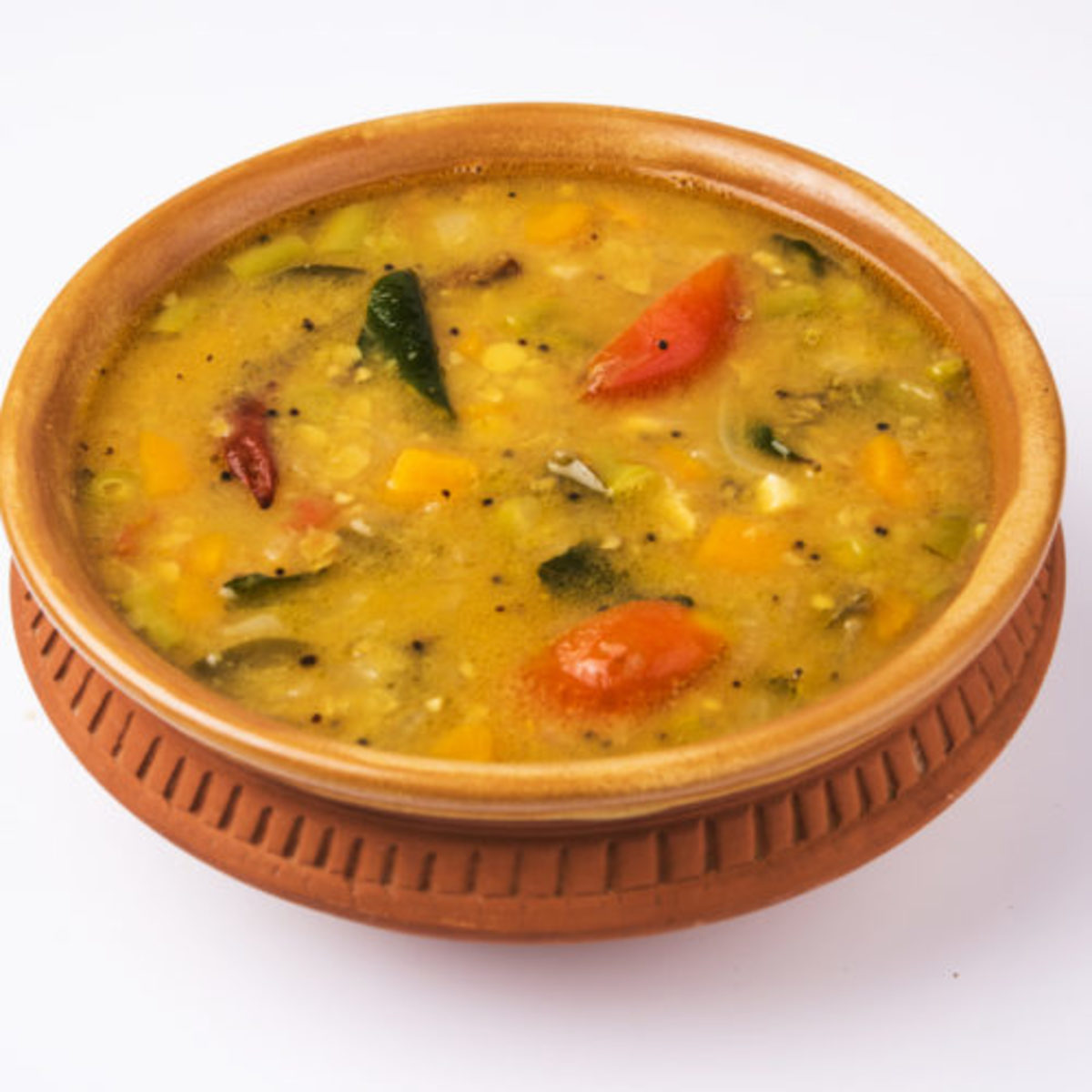

Instructions for making Sambar
Total time: 20 minutes
Rinse the toor dal and add it to a pressure cooker with 2 cups of water, turmeric powder, and salt.


Add little turmeric and salt according to taste.
Pressure cook for about 4-5 whistles or until the dal is cooked.
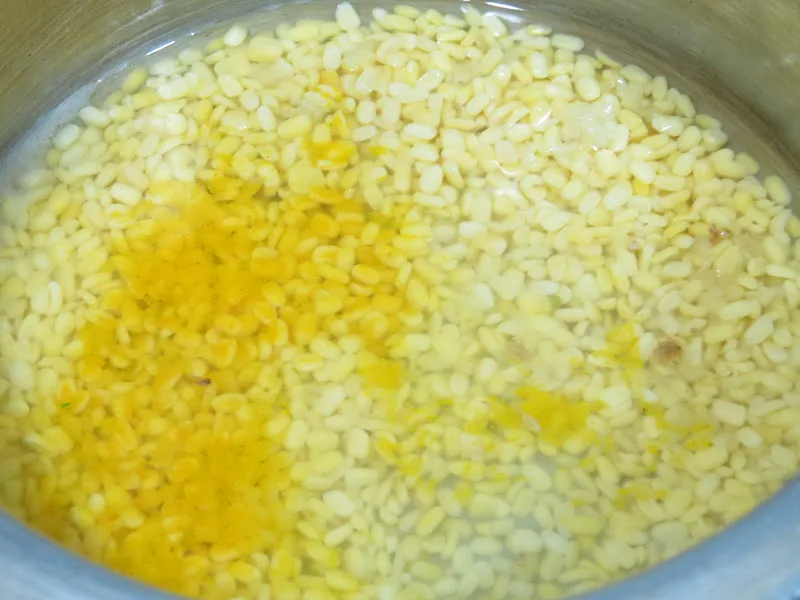

Do not Over cook the Dal
Mash the dal using a spoon or a potato masher and keep it aside.
Heat oil in a pan and add mustard seeds, cumin seeds, and asafoetida powder.


Be careful while adding the Mustard seeds as they pop up when heated.
Once the mustard seeds start spluttering, add chopped onions and green chillies. Saute until the onions become translucent.
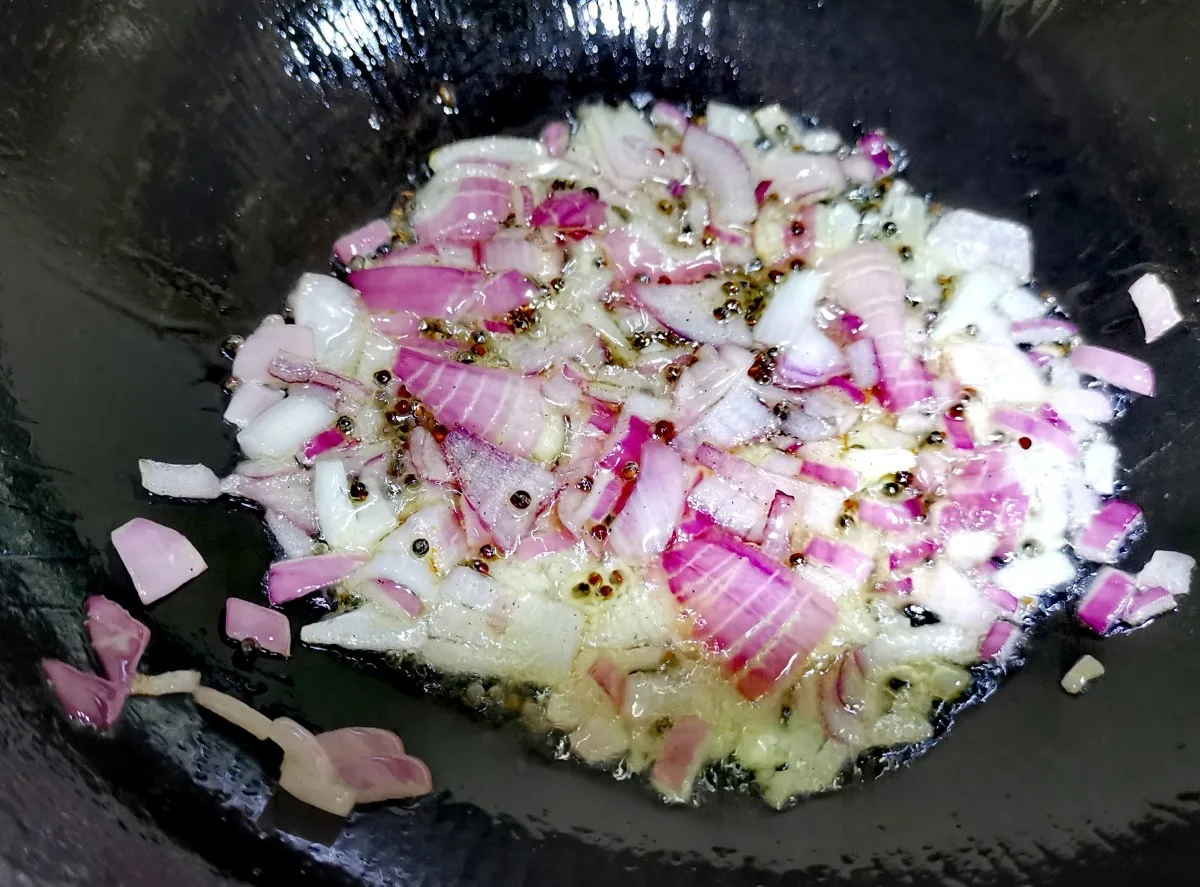

Sauté the onions until they become Golden brown.
Add chopped tomatoes and cook until they turn soft and mushy.
Add tamarind pulp and sambar powder, mix well and cook for 2-3 minutes.
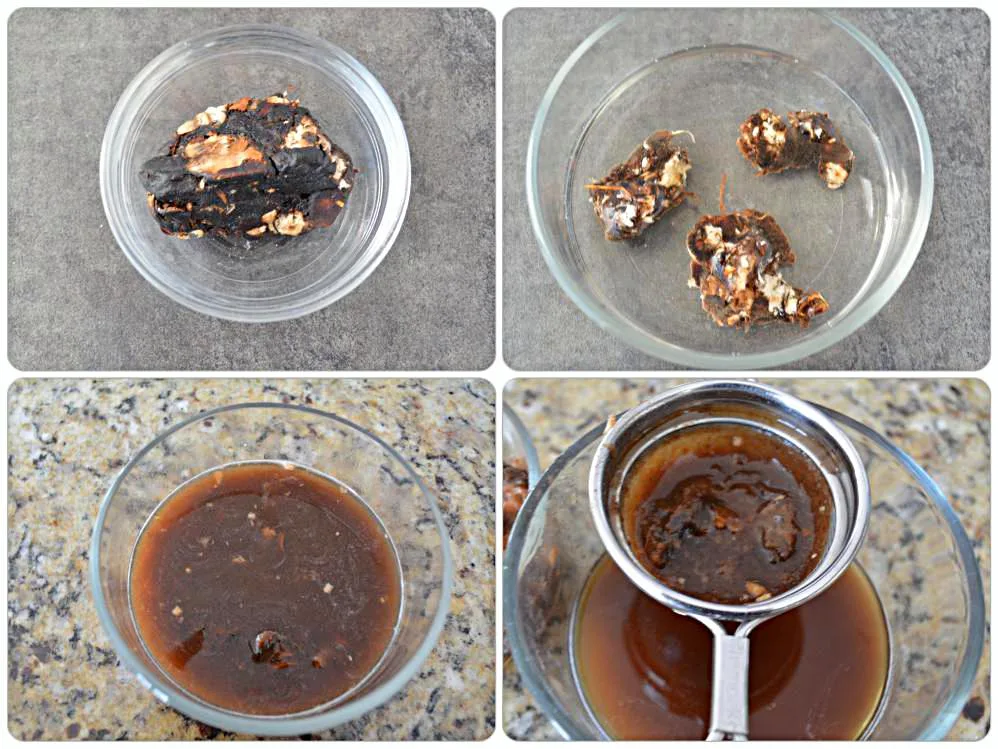

This step is essential as if you will not add the Tamarind your sambar will get bitter.
Add the cooked dal to the pan and mix well. Add water to adjust the consistency of the sambar.
Let the sambar boil for a few minutes and then turn off the heat
Garnish with curry leaves and coriander leaves.
For Dosa:
Ingredients:
- 1 cup rice
- 1/2 cup urad dal (split black gram)
- 1/4 teaspoon fenugreek seeds
- Salt to taste
- Oil or ghee
Instructions:
- Rinse the rice, urad dal, and fenugreek seeds separately.
- Soak the rice, urad dal, and fenugreek seeds in enough water for 4-6 hours.
- Drain the water and grind the soaked rice and urad dal separately in a blender.
- Mix the ground rice and urad dal together in a large bowl, add salt and mix well. Let it ferment overnight.
- The next day, mix the fermented batter well.
- Heat a non-stick pan or a dosa tawa and pour a ladleful of the batter on it.
- Spread the batter in a circular motion to form a thin dosa. Drizzle some oil or ghee on top.
- Cook the dosa on medium heat until it turns golden brown.
- Flip the dosa and cook for a few seconds on the other side.
- Serve hot with sambar and chutney.
Enjoy your homemade dosa sambar!


Idli
To make idlis at home, you will need to follow these steps:
Ingredients:
- 2 cups idli rice or parboiled rice
- 1 cup urad dal (split black gram)
- 1/4 teaspoon fenugreek seeds
- Salt to taste
- Water
Instructions:
- Rinse the rice, urad dal, and fenugreek seeds separately.
- Soak the rice and fenugreek seeds in enough water for 4-6 hours.
- Soak the urad dal in enough water for 4-6 hours.
- Drain the water and grind the soaked rice and fenugreek seeds in a blender, adding water as needed. Grind until the batter is smooth.
- Transfer the rice batter to a large bowl.
- Drain the water from the soaked urad dal and grind it in a blender, adding water as needed. Grind until the batter is smooth and fluffy.
- Add the urad dal batter to the rice batter and mix well.
- Add salt to taste and mix well.
- Cover the bowl with a lid or cloth and let the batter ferment overnight or for about 8-10 hours.
- The next day, mix the fermented batter well.
- Grease the idli plates with oil or ghee.
- Pour a ladleful of the batter into each idli mold.
- Steam the idlis in an idli cooker or pressure cooker for about 10-12 minutes on medium heat.
- Turn off the heat and let the idlis rest for 2-3 minutes.
- Take out the idlis from the mold using a spoon or knife.
- Serve hot with chutney and sambar.
Enjoy your homemade idlis!
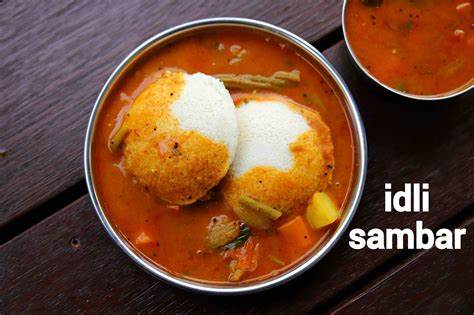

Coconut chutney
To make coconut chutney at home, you will need to follow these steps:
Ingredients:
- 1 cup grated coconut (fresh or frozen)
- 1 green chili, chopped
- 1 small onion, chopped
- 1/2 inch ginger, chopped
- 2-3 garlic cloves
- 1/2 teaspoon mustard seeds
- 1/2 teaspoon cumin seeds
- A pinch of asafoetida powder
- Salt to taste
- Water
- Coriander leaves (optional)
Instructions:
- Add grated coconut, chopped green chili, onion, ginger, and garlic cloves to a blender or a mixer grinder.
- Add a little water and grind to a smooth paste. Add more water if needed to get the desired consistency.
- Transfer the chutney to a bowl and keep it aside.
- Heat oil in a small pan and add mustard seeds, cumin seeds, and asafoetida powder.
- Once the mustard seeds start spluttering, pour the seasoning over the chutney and mix well.
- Add salt to taste and mix well.
- If the chutney is too thick, add some water to adjust the consistency.
- Garnish with coriander leaves if desired.
- Serve the coconut chutney with idlis, dosas, vadas or any South Indian dish of your choice.
Enjoy your homemade coconut chutney
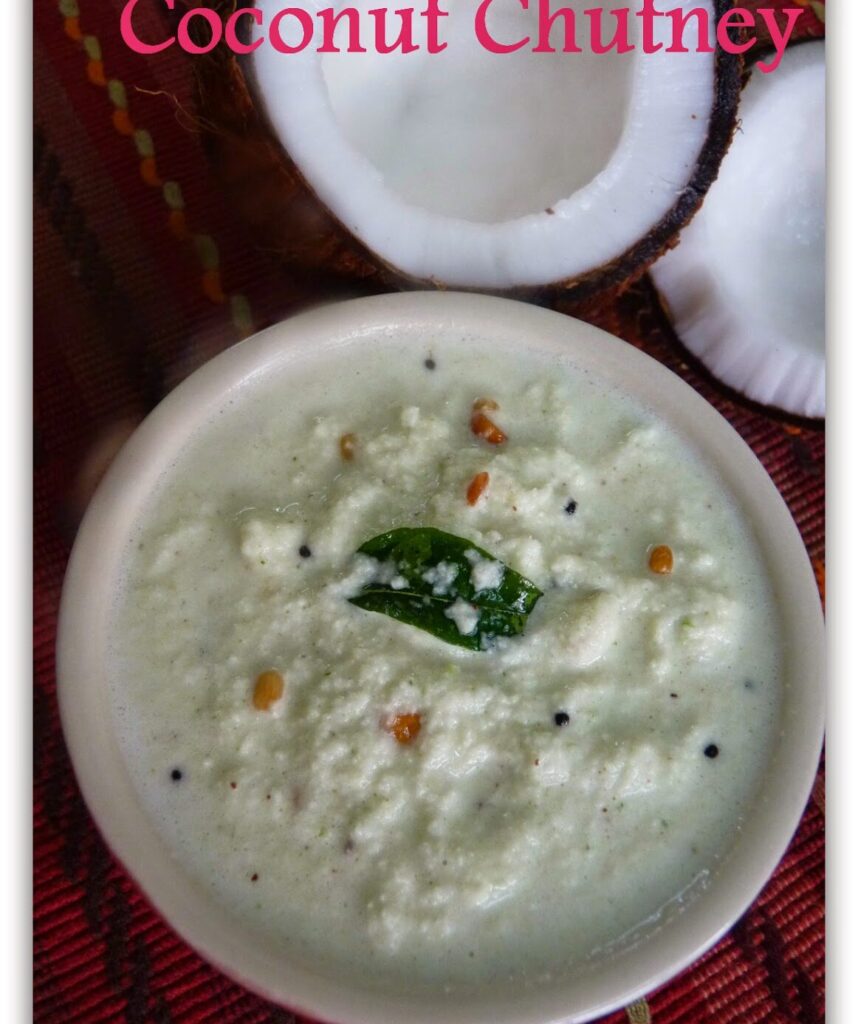

Uttapam
To make uttapam at home, you will need to follow these steps:
Ingredients:
- 1 cup dosa batter
- 1 small onion, finely chopped
- 1 small tomato, finely chopped
- 1 small capsicum, finely chopped
- 1-2 green chilies, finely chopped
- A few curry leaves, chopped
- Salt to taste
- Oil or ghee for cooking
Instructions:
- Heat a non-stick tawa or griddle on medium heat.
- Grease the tawa with a little oil or ghee.
- Take a ladleful of dosa batter and pour it onto the tawa.
- Spread the batter in a circular motion to make a thick pancake.
- Sprinkle chopped onion, tomato, capsicum, green chilies, and curry leaves on the pancake.
- Press the vegetables lightly with a spatula so that they stick to the batter.
- Drizzle some oil or ghee around the edges of the pancake.
- Cook the uttapam on medium heat until the bottom turns golden brown.
- Flip the uttapam and cook the other side until it turns golden brown.
- Serve the uttapam hot with coconut chutney or sambar.
Enjoy your homemade uttapam!
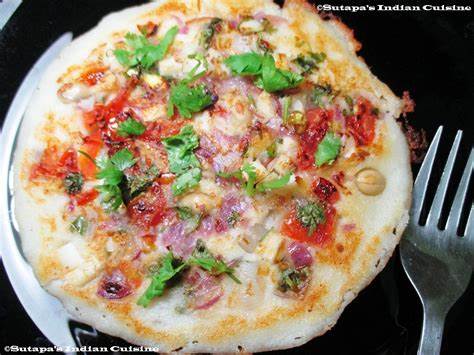

Nutritional value of south Indian platter
The nutritional value of a South Indian platter varies depending on the dishes included, portion sizes, and cooking methods. However, as a general overview, South Indian Platter is known for its use of fresh ingredients, aromatic spices, and vegetarian options. Here are some nutritional benefits of some of the most common dishes in a South Indian platter:
- Idli: Idlis are made from fermented rice and lentil batter, which makes them a good source of protein, dietary fiber, and carbohydrates. They are low in fat and calories, making them an excellent choice for weight management.
- Dosa: Dosas are also made from fermented rice and lentil batter and are a good source of protein, dietary fiber, and carbohydrates. They are low in fat and calories, making them a healthy option for weight management.
- Sambar: Sambar is a lentil-based vegetable stew that is packed with nutrients. It contains lentils, vegetables, and spices that provide a good amount of protein, dietary fiber, vitamins, and minerals.
- Coconut Chutney: Coconut chutney is made from fresh grated coconut, which is a good source of dietary fiber and healthy fats. It also contains other ingredients such as ginger, garlic, and green chilies, which provide additional health benefits.
Uttapam
- Carbohydrates: Uttapam is an excellent source of carbohydrates as it is made from rice and lentil batter. Carbohydrates are essential for providing energy to the body.
- Protein: Uttapam is a good source of protein as it contains lentils in the batter. Protein is essential for building and repairing body tissues.
- Fiber: Uttapam is a good source of dietary fiber, which is essential for maintaining a healthy digestive system.
- Vitamins and minerals: Uttapam contains several vitamins and minerals such as iron, calcium, and vitamin B-complex that are important for maintaining good health.
Overall, a South Indian platter can be a healthy and balanced meal that provides a good mix of carbohydrates, protein, dietary fiber, vitamins, and minerals. However, it is essential to be mindful of portion sizes and the amount of oil and salt used in cooking.
Health Benefits
A traditional South Indian platter, also known as a South Indian Thali, typically consists of a variety of dishes that are packed with flavors and nutrients. Here are some potential health benefits of a balanced South Indian platter:
- Rich in Vegetables: South Indian platters often include a variety of vegetable-based dishes like sambar, rasam, poriyal, aviyal, and thoran. These dishes provide a wide range of vitamins, minerals, fiber, and antioxidants, promoting overall health and supporting the immune system.
- Plant-Based Proteins: Many South Indian platters include protein-rich lentil-based dishes like sambar and dal. Lentils are an excellent source of plant-based protein and essential amino acids, making the platter suitable for vegetarians and vegans.
- Fermented Foods: Some South Indian platters include fermented foods like idli and dosa, which are made from fermented rice and lentil batter. Fermented foods promote gut health by providing beneficial probiotics that support digestion and nutrient absorption.
- Healthy Fats: Coconut is a common ingredient in South Indian cuisine and is often used in dishes like chutneys and curries. Coconut provides healthy fats that have been associated with heart health and cognitive function.
- Spices with Health Benefits: South Indian dishes are flavored with a variety of spices like turmeric, cumin, coriander, and mustard seeds. These spices are rich in antioxidants and have anti-inflammatory properties, which may support overall well-being.
- Balanced Carbohydrates: South Indian platters typically include a variety of carbohydrates from rice, lentils, and other grains. These carbohydrates provide energy and can be beneficial when balanced with other nutrients.
- Hydration: Many South Indian dishes, such as rasam and buttermilk, are hydrating and can help maintain proper fluid balance in the body.
- Low in Processed Foods: Traditional South Indian cuisine is generally low in processed foods, which can be beneficial for overall health and weight management.
- Gluten-Free Options: Many South Indian dishes are naturally gluten-free, making them suitable for individuals with gluten sensitivity or celiac disease.
- Culinary Diversity: South Indian cuisine offers a wide variety of dishes, ensuring a diverse intake of nutrients and flavors in the platter.
It’s essential to enjoy South Indian platters in moderation, considering portion sizes and overall dietary balance. While the traditional dishes offer numerous health benefits, the use of excessive oil, salt, or sugar should be minimized to maintain a balanced and nutritious diet.
As with any cuisine, it’s best to incorporate a variety of foods from different food groups to meet your specific nutritional needs and health goals. If you have dietary restrictions or specific health concerns, consulting with a registered dietitian can help you create a personalized and healthy South Indian meal plan.
Tips and Tricks
Creating a delicious and authentic South Indian platter, also known as a South Indian Thali, involves a variety of dishes that showcase the region’s diverse flavors and culinary traditions. Here are some tips and tricks to make a flavorful and well-balanced South Indian platter:
- Balance of Flavors: Aim for a balance of flavors in the platter, including sweet, salty, sour, spicy, and bitter. Include dishes like sambar (sour and spicy lentil stew), coconut chutney (sweet and coconutty), and rasam (tangy and spicy soup) to achieve this balance.
- Variety of Dishes: A typical South Indian platter includes a variety of dishes, such as rice, lentils, vegetable-based curries, and fermented items like idli and dosa. Aim to have at least one or two dishes from each category to offer a diverse eating experience.
- Fresh Ingredients: Use fresh and seasonal ingredients to enhance the flavors and nutritional value of the dishes. South Indian cuisine celebrates the use of local produce and aromatic spices.
- Homemade Spices: Consider making your own spice blends and pastes, such as sambar powder or rasam paste. Homemade spices add an authentic touch and better control over the ingredients.
- Tadka or Tempering: The process of tempering (tadka) is crucial in South Indian cooking. It involves heating oil or ghee and adding mustard seeds, urad dal, curry leaves, and sometimes dried red chilies. The aromatic tempering is then added to various dishes, enhancing their flavors.
- Use of Coconut: Coconut is a staple in South Indian cuisine and is often used in chutneys, curries, and desserts. Freshly grated coconut adds a distinct taste and texture to the dishes.
- Include Fermented Foods: Fermented foods like idli, dosa, and appam are common in a South Indian platter. These dishes are not only delicious but also promote gut health due to their probiotic content.
- Serve with Love: South Indian cuisine is often served on a banana leaf or a traditional platter. Consider presenting the dishes with care and attention to detail to enhance the dining experience.
- Offer Accompaniments: Along with the main dishes, include a variety of accompaniments like pickles, papads, yogurt, and pachadis (chutneys) to add more flavors and textures to the platter.
- Balance Spiciness: Be mindful of the spiciness levels in the dishes to cater to various taste preferences. If you have guests with varying spice tolerances, consider offering milder and spicier options.
- Include Sweet Dish: A sweet dish like payasam (kheer) or halwa is often included in a South Indian platter to provide a sweet ending to the meal.
Remember, a South Indian platter offers a plethora of options, and you can customize it based on your preferences and the availability of ingredients. Enjoy the process of creating and savoring the rich and flavorful dishes that make up this delightful culinary experience.
Serving Suggestions
The South Indian platter offers a delightful assortment of flavors and textures. Here’s a suggested arrangement for an authentic and appetizing experience:
- Rice: Start by placing a generous serving of steamed white rice or aromatic biryani rice in the center of the platter. Rice is a staple and acts as the base for the other dishes.
- Sambar: Pour a ladleful of piping hot sambar next to the rice. Sambar is a flavorful lentil-based vegetable stew that complements the rice perfectly.
- Rasam: On the other side of the rice, add a serving of tangy and spicy rasam. Rasam is a comforting soup-like dish that cleanses the palate.
- Poriyal/Thorhan: Surround the rice with colorful vegetable stir-fries like carrot poriyal or beans thoran. These add a nutritious and crunchy element to the platter.
- Avial: Place a scoop of avial, a unique mix of various vegetables cooked in a coconut-based gravy, near the rice. Avial adds a creamy and aromatic touch to the meal.
- Coconut Chutney: Offer a small bowl of coconut chutney, which complements the main dishes and serves as a cooling accompaniment.
- Pickle: Include a small portion of your favorite South Indian pickle for an added tangy and spicy kick.
- Papad: Add some crispy papadams or appalams on the side of the platter for a delightful crunch.
- Curd/Yogurt: Provide a bowl of fresh yogurt or curd to soothe the taste buds and balance the spiciness.
- Dessert: End the meal on a sweet note with a traditional South Indian dessert like payasam (kheer), kesari (semolina pudding), or sweet pongal.
- Banana: As a customary South Indian tradition, serve a ripe banana on the side, which is believed to aid digestion and provide a natural sweetness.
Remember to serve the dishes hot and fresh. Enjoy this South Indian platter with your loved ones and relish the diverse and mouthwatering flavors it has to offer!
FAQ’s
What is Platter in a food?



A platter in food refers to a large, flat serving dish that is used to present a variety of food items. A food platter can be used for serving appetizers, main dishes, or desserts. The platter can be made from a variety of materials such as wood, plastic, or metal, and can come in different shapes and sizes.
A food platter typically features an assortment of food items that are arranged in an aesthetically pleasing way. For example, a cheese platter may include different types of cheese, crackers, and fruits, all arranged in an attractive way. Similarly, a vegetable platter may include a variety of vegetables such as carrots, cucumbers, and peppers, arranged in a visually appealing way.
Platters are often used for serving food at parties, gatherings, or special occasions. They can also be used in restaurants as a way to present and serve food to customers. Overall, a food platter is a great way to showcase an assortment of food items and can add a touch of elegance and sophistication to any meal or event
What is Health Benefit of Eating South Indian Platter?



A South Indian platter consisting of sambar, dosa, idli, coconut chutney, and uttapam offers several health benefits.
Sambar, a lentil-based soup, is rich in protein, fiber, and essential nutrients. It provides a good balance of carbohydrates and proteins, promoting satiety and maintaining steady blood sugar levels.
Dosa and idli are fermented rice and lentil batter-based dishes, which are easy to digest and have a low glycemic index. They provide complex carbohydrates and are a good source of energy.
Coconut chutney is made from grated coconut, which is rich in healthy fats and fiber. It adds flavor and provides essential nutrients like potassium and magnesium.
Uttapam is a savory pancake made with fermented batter, similar to dosa. It is a good source of protein and carbohydrates, making it a satisfying and nutritious option.
Overall, this South Indian platter offers a balanced combination of nutrients, including proteins, fiber, complex carbohydrates, and healthy fats, contributing to a well-rounded and healthy meal.

